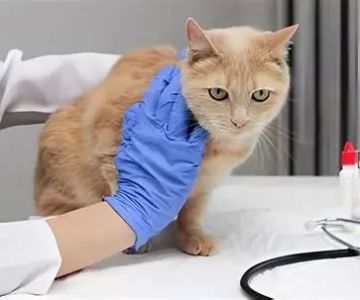- 1 - understanding-pet-terminal-illnesses
- 2 - providing-comfort-in-pets-final-days
- 3 - managing-pain-and-discomfort-for-pets
- 4 - creating-a-peaceful-environment-for-your-pet
- 5 - recognizing-signs-your-pet-needs-extra-care
- 6 - practical-steps-to-aiding-terminally-ill-pets
- 7 - veterinary-support-for-terminally-ill-pets
- 8 - emotional-preparation-for-pet-owners
- 9 - when-to-consider-palliative-care-or-hospice
- 10 - how-hidden-brook-veterinary-helps-you-care-for-pets
1 - Understanding Pet Terminal Illnesses
As our beloved pets age or face terminal illnesses, understanding what they’re going through is the first step to helping them. Helping pets with terminal conditions requires empathy, observation, and a willingness to provide comfort during their final days.
1.1 - Common Terminal Conditions in Pets
Pets, like humans, are susceptible to various terminal conditions, including cancer, heart disease, kidney failure, and neurological disorders. These conditions often come with a range of symptoms that require careful management.
1.2 - Recognizing the Signs of Terminal Illness
Recognizing the signs of a terminal condition can help you make informed decisions. Common signs include loss of appetite, lethargy, difficulty breathing, and changes in behavior. It’s essential to work closely with your veterinarian to determine the best approach for your pet’s condition.
2 - Providing Comfort in Your Pet’s Final Days
When a pet is nearing the end of its life, their comfort becomes a top priority. Helping pets with terminal conditions means providing them with a peaceful, loving environment that alleviates stress and discomfort.
2.1 - Soft Bedding and Comfortable Spaces
Provide your pet with soft bedding and a quiet, calm space. Consider using orthopedic mattresses to alleviate joint pain or make it easier for them to move around. Create a cozy nook where they can rest undisturbed, close to family members for emotional support.
2.2 - Maintaining Familiar Routines
Sticking to familiar routines can help your pet feel more at ease. Consistent feeding times, regular potty breaks, and gentle playtime can bring comfort during this period. Make sure to provide them with frequent affection and reassurance.
3 - Managing Pain and Discomfort for Pets
Many pets with terminal conditions experience pain or discomfort. Effective pain management is crucial to improving your pet’s quality of life during their final days.
3.1 - Pain Relief Medication
Your veterinarian will likely prescribe pain relief medications, such as opioids or NSAIDs, to keep your pet comfortable. Never administer over-the-counter pain medications to your pet without a veterinarian’s guidance, as some can be toxic.
3.2 - Alternative Therapies for Comfort
In addition to medication, alternative therapies like acupuncture, massage, or aromatherapy may help manage your pet’s pain and anxiety. Speak to your vet about any complementary treatments that might be appropriate for your pet’s condition.
4 - Creating a Peaceful Environment for Your Pet
Providing a serene and comforting environment is essential when helping pets with terminal conditions. A calm environment can help reduce anxiety and make the final days more peaceful for both you and your pet.
4.1 - Dimming the Lights and Reducing Noise
Pets are sensitive to their surroundings, and bright lights or loud noises can be distressing, especially when they are not feeling well. Keep the lighting soft and reduce unnecessary noise. Play calming music or white noise to create a soothing atmosphere.
4.2 - Keeping Visitors to a Minimum
While it’s natural for friends and family to want to visit, keep the number of visitors to a minimum to avoid overwhelming your pet. Let your pet rest in peace without too much stimulation.
5 - Recognizing Signs Your Pet Needs Extra Care
As your pet’s condition progresses, you may notice that they require extra care. Recognizing these signs is essential for ensuring your pet’s comfort and well-being.
5.1 - Difficulty Breathing or Walking
Pets with terminal conditions may have difficulty breathing or moving. If your pet seems to struggle for air or has difficulty walking, consult your veterinarian about ways to manage these symptoms.
5.2 - Loss of Interest in Food or Water
Loss of appetite is common in terminally ill pets. Offer easily digestible food and ensure they have access to water at all times. If they are unable to eat or drink, your veterinarian may recommend hydration therapies or appetite stimulants.
6 - Practical Steps to Aiding Terminally Ill Pets
Being proactive about your pet’s care can make a significant difference in their comfort. Here are some steps you can take to help them feel more at ease:
6.1 - Regular Veterinary Checkups
Frequent visits to your veterinarian ensure that your pet’s condition is being managed effectively. They can adjust medications as needed and provide guidance on managing symptoms.
6.2 - Ensuring Hydration
Keeping your pet hydrated is essential for their comfort. If they are unwilling to drink, try offering ice cubes, broths, or wet food to ensure they are getting enough fluids.
7 - Veterinary Support for Terminally Ill Pets
Your veterinarian plays a crucial role in providing care and support for terminally ill pets. They can offer specialized treatments, monitor your pet’s progress, and guide you through the decision-making process.
7.1 - Palliative Care
Palliative care focuses on relieving your pet’s symptoms without trying to cure the illness. It includes pain management, emotional support, and comfort measures to improve your pet’s quality of life.
7.2 - Hospice Care for Pets
Hospice care involves providing end-of-life care in the pet’s home environment. This option can offer a peaceful transition and allows for more personalized care, including medications, comfort measures, and emotional support for both pet and owner.
8 - Emotional Preparation for Pet Owners
Preparing yourself emotionally for the loss of a pet can be challenging. Understanding that your pet’s suffering is being managed and that you are providing them with love and care can bring peace to both of you during this difficult time.
8.1 - Understanding Grief
Grief is a natural response to losing a pet. Give yourself time to process your emotions and lean on your support system. Speaking with a counselor or pet loss support group can also be helpful.
8.2 - Saying Goodbye
When the time comes to say goodbye, make the decision that is right for you and your pet. Your veterinarian can guide you in making the choice, ensuring that your pet’s comfort is the top priority.
9 - When to Consider Palliative Care or Hospice
Consider palliative or hospice care when your pet’s condition no longer responds to curative treatments. If your pet’s quality of life is declining and they are no longer enjoying the activities they once did, it may be time to explore these options.
9.1 - Knowing When the Time Is Right
Consult with your veterinarian about the options available for palliative and hospice care. They will help you determine if these services are appropriate for your pet’s condition and guide you through the process.
10 - How Hidden Brook Veterinary Helps You Care for Pets
Hidden Brook Veterinary offers compassionate care for terminally ill pets. Our team is here to help you navigate the difficult journey of caring for a pet with a terminal condition, ensuring that your pet remains as comfortable as possible during their final days.
10.1 - Our Approach to End-of-Life Care
At Hidden Brook Veterinary, we prioritize comfort and emotional support. Our team works closely with pet owners to create a personalized care plan that addresses both physical and emotional needs, offering guidance and services such as pain management, hospice care, and grief support.
If you are facing the difficult challenge of caring for a terminally ill pet, contact Hidden Brook Veterinary to learn more about how we can help you provide the best care for your beloved companion.











